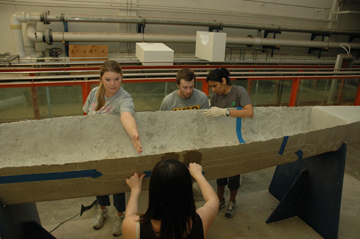Will it float? Students design concrete canoe for competition
It’s easier to envision a chunk of concrete sinking to the bottom of a pond than floating on its surface, but a group of University of Kansas School of Engineering students are pinning their hopes on an environmentally friendly mixture of the bonding material to accomplish that feat — and earn a spot at a national competition.
Thirteen engineering students are putting the finishing touches on “Yellow Submarine,” the entry in this year’s 2010 Concrete Canoe Competition, taking place April 22-24 in Norman, Okla., as part of the Mid-Continent Student Conference of the American Society of Civil Engineers.
Co-captains Lucy Munz and Vinur Kaul lead a crew that put in more than 500 hours this year to prepare the vessel for its maiden voyage.

Munz said the long hours are worth it for the challenge and unique opportunities.
“It’s something that a lot of times you wouldn’t get to do as a typical student,” Munz said. “I mean, you get to build beams and cylinders, but you’ll never get to build an actual structure until you’re out in the work force. Plus, it’s such a unique project — I mean, how many people get to build a concrete canoe?”
Teams are required this year to use at least 50 percent recycled material as they prepare the concrete mixture for the canoe. It’s the makeup of that mixture, or aggregate, that holds the key to keeping the canoe afloat.
“Basically in normal construction, you’d use gravel and sand that’s pretty heavy, but in our case we used something that’s a lot lighter,” Kaul said. “We used glass beads, ceramic beads and rubber mulch. That made it lighter, which will help it float. As long as it’s lighter than the unit weight of water, you’d expect it to float.”
In addition to the environmentally friendly requirements, teams are judged on four categories: aesthetics, oral presentation, design and racing. Each category counts for 25 percent of the overall score.
Munz and Kaul will each be in the canoe during the racing portion of the competition.
“I’m the only girl who knows how to steer,” Munz said. “It takes a lot more to move, because it’s heavier, it sits a lot higher, and it’s also two feet longer than a regular canoe. It’s tough to steer.”
The work starts at the beginning of the school year with fundraising — about $2,000 was needed for this year’s canoe — and collecting materials. Construction begins at the start of the spring semester.
Twelve universities will compete for a spot in the national competition in June in California.